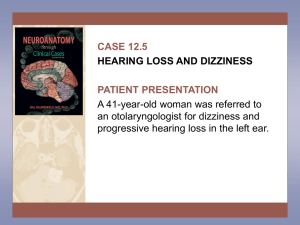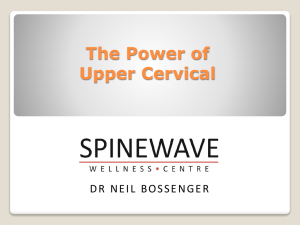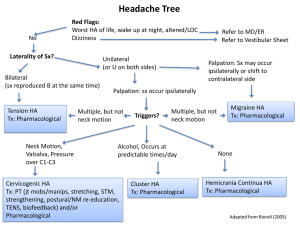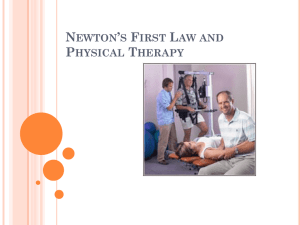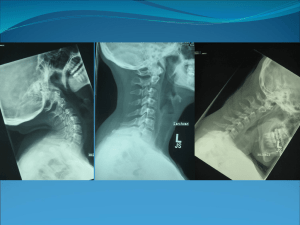Cervicogenic Dizziness Description
advertisement
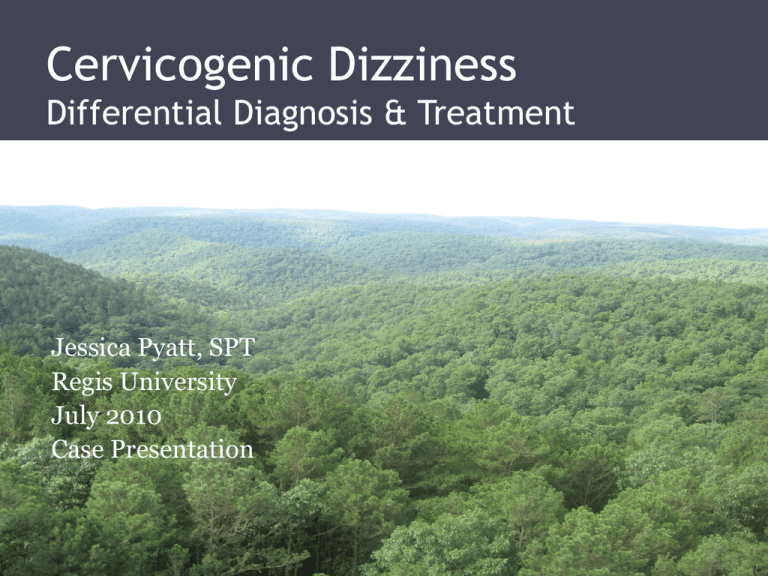
Cervicogenic Dizziness Differential Diagnosis & Treatment Jessica Pyatt, SPT Regis University July 2010 Case Presentation Objectives • By the completion of this case presentation the audience will: ▫ Be able to indicate potential patient presentation/ history items in individuals with cervical spine associated dizziness ▫ Be able to transfer evaluative T&M to the differential diagnosis of individual’s with / without cervicogenic dizziness. ▫ Ascertain potential treatment options for patients with cervicogenic dizziness Why Should I Care? • 8 Million primary care visits for dizziness / year • Individuals over 65 y/o: ▫ 39% of falls partial attributable to dizziness • Whiplash Associated Disorder ▫ Resulting Dizziness in: ▫ 40-80% ▫ 20-58% • 1/3 of individuals with neck pain also have dizziness ▫ Prolonged disability / pain Humphreys 2008; Reid 3005 Patient Presentation • Female, 62 y/o • L > R scapular / upper trap and neck pain • Headaches & Dizziness: ▫ along temples, behind eyes with nausea and dizziness ▫ “head does not belong to my body” “disorientated/off” • Light headedness: ▫ stands too fast / up at night • Falls 2-3 x / week • Worse: ▫ with/at work, stress, computer use, rotating head & neck • Better: ▫ pain medication, self message, up and moving around (walking/not at computer) Medical History • Breast cancer: ▫ L mastectomy, Tran Flap reconstruction, R lumpectomy & radiation • Osteoporosis • Scoliosis • Arthritis: neck, low back, ▫ Jt pain & swelling • • • • • HTN ∞ Stomach / GI / IBS Depression ∞, anxiety ∞ (including sleeping medication) Difficult concentrating, fatigue & stress Patient report of unremarkable imaging ***** ∞ Medications Observation • • • • • • • • Guarded Slight forward head posture “cranial shift’’/ upper cervical SB Nodding of head / neck to look over glasses L shoulder elevation Flat thoracic spine Thoracic: R convexity scolosis Palpation: ▫ Thoracic right prominence throughout / R rotated, ▫ B upper trap / scapular/ RTC tenderness / spasm ▫ B 1st rib tenderness Screening Exam • BP 124/78 • Strength: WNL • Sensation: ▫ WNL to light touch bilaterally • Reflexes: 2+ symmetrical • Hoffman’s: negative • Cervical ROM: ▫ ▫ ▫ ▫ Flexion: 56 (WNL) Extension 75 (WNL) ∞ “tight” Sidebend: L = 57 R = 46 ∞ “tight” Rotation: L = 68 R = 55 limited, slight provocation Differential ?????? Differential • • • • • • • • • • • • Wrisley, 2000; Landel 2010; Brandt, 2001 BPPV Perilymphatic fistual Labyrinthine concussion Migraine –related vertigo, photophobia Central / peripheral vestibular dysfunction VBI – vetebral basilar insufficiency Vestibular system / vestibular nerve Brain injury / central vestibular Orthostatic Hypotension / vascular Double vision – glasses Oculomotor Drugs / alcohol intoxication “Diagnosis of Exclusion” • Rule Out Red Flags: ▫ ▫ ▫ ▫ Oculomotor tests Nystagmus-??? Smooth pursuit - ???? Vetebral Artery • Peripheral : ▫ Position ▫ Hallpike ▫ ENG/VNG • Orthostatic Hypotension Cervicogenic Dizziness Description • • • • • • • • • Vague Not spinning / vertigo like Unsteady Spacey Disconnected Disoriented Floating Lightheaded – without faint feeling Difficult concentrating Special Tests • Sharp Pursuer: Negative • Alar Ligamant testing (SB & rotation): negative • Transverse Ligament Test: ▫ Negative ??? ▫ Prolonged hold 30 seconds = slight nausea On a bad day / retesting • OA nodding / AA rotation ▫ Symmetrical ▫ AA slight limitation Special Tests • Sustained End Range Rotation: Negative bilaterally ▫ No change in blood flow at C1/2, C5/6 during hold ▫ Reduction on return to neutral ▫ Rest period for pre-manipulative / manual testing Zaina 2003 • Spurlings: ▫ Bilaterally reproduced upper cervical pain, no UE s/s • Compression: ▫ reproduces L sided neck pain • CRLF: + Right Cervical vs Vestibular Move body under head: Head and neck together as one unit: + symptoms suggests cervical + symptoms central or peripheral vestibular involvement involvement + with body turn L / R cervical rotation Sensory Systems Visual Vestibular Somatosensory C1-C3 Mechanoreceptors Cervical Dorsal Roots Vestibular Nuclei Superior Colliculus Coordinate visual & cervical motion Sensory Cervicogenic • • • • • • • • • • Vague dizziness description Episodes with neck movement Imbalance Occipital/ bi-temporal headaches Episodic dizziness minutes to hours ***** “head not straight” Not walking straight Falls Impaired ROM Oculomotor abnormalities Cervicogenic Dizziness • Dizziness & Neck Pain Together • Postural control / increased sway • Cervical muscle function ▫ DNF ▫ Extensors • Joint position errors • Temperature hypersensitivity • Post-traumatic stress Neck Pain Manual PT of Cervicogenic Dizziness: A Systematic Review (Reid 2005) Low quality – Level 3 Evidence Positive / Significant improvement with manual PT Wrisley, 2000: 73-82% of patients reduced s/s with manual PT Karlberg, 1996 Malmstrom 2007 Treatments: Jt mobilization Soft Tissue Stabilization Relaxation Ergonomic Self “SNAG” Reid, 2008 Postural Control • Balance Training Posture & Ergonomics Cervical Flexion Test • Staged test of deep cervical flexor motor control • Air filled stabilizer sensor • Start: 20 mmHg, 2 mmHg increments ▫ Hold 5 or 10 seconds ▫ No SCM contraction / no head lift • Results: 26 mmHg x 10 sec Jull, 2000; Falla 2003, 2004 • WAD average 23+/- 1.3 mm, • Asymptomatic average 28 +/- 1.7 mmHg Deep neck flexor endurance: 23 seconds Cervical Extensors Joint Position Error • 90 cm from wall • Eyes closed • Angle = tan-1 (error distance / 90 cm) ▫ 7.1 cm = 4.5 degrees ▫ Greater than 4.5 degrees = impairment • Lee, 2006 test, retest reliability of assessing jt position error • Kristjansson 2009 Expert Opinion / Clinical Review • Lee, 2006: Test-retest reliability of cervicocephalic kinestathic sensibility • Jull 2007: Reduction in jt position error with training • Revel, 1994 Outcomes…....Still to Come • Dizziness VAS: 6/10 average at intake • NDI : ▫ 6-2-10: 14/50 or 28% ▫ 6-16-10: 24/50 or 48% 6-16 • FABQPA: 12/24 • FABQW: 20/42 • Pain VAS: 6-7/10 ---- 2/10 ---- 3-4/10 • Decreased frequency of dizziness sxs / week Du, du, du, du…du, du, duuuu. Du, du, du, du DU, dudududuuu. • Name one sxs that must accompany ‘dizziness’ to be cervicogenic in origin…… • Cervicogenic dizziness is described as……….. • Normal deep neck flexor endurance is ______. • Normal cervical joint position error is less than ________ degrees. Psychosocial Aspects • • • • • • • Emotional Disorientation Depression Anxiety Fear of open spaces Inability to perform ADLs Employment (Gudleski, 2005) 7-14 Days Stress Episodes IBS / Pain / Dizziness References • • • • • • • • • • Alix ME, Bates DK. A proposed etiology of cervicogenic headache: the neurophysiologica basis and anatomic relationship between the dura mater and the rectus capitis minor muscle. J Manipulative Physio Ther. 1999; 22: 534-539. Brandt T, Bronstein AM. Cervical vertigo. J Neurol Neurosurg Psychiatry. 2001. 71: 8-12. Eldridge L, Russel J. Effectiveness of cervical spine manipulation and prescribed exercise in reduction of cervicogenic headache pain and frequency: a single case study experiemental design. Int J Osteo Med. 2005; 8: 106-113. Landel R. Cervicogenic dizziness: perspectives on evaluation and treatment. American Physical Therapy Association. Combined Sections Meeting. San Diego, CA. 2010 Falla DL, Jull GA, Hodges PW. Patients with neck pain demonstrate reduced electromyographic activity of the deep cervical flexor muscles during performance of the craniocervical flexion test. Spine. 2004; 29: 2108-2114. Falla DL, Campbell CD, Fagan AE, Thompson DC, Jull GA. Relationship between cranio-cervical flexion range of motion and pressure change during the cranio-cervicla flexion test. Manual Ther. 2003; 8: 92-96. Gudleski GD. Major disasters, stress and GI symptos: the September 11th tragedy and its effect on persons with irritable bowel syndrome. State University of New York at Buffalo Thesis. 2005. DAI-B 66/08, p. 4482. Huijbregts P. Vidal P. Dizziness in oprthopaedic physical therapy practice: classification and pathophysiology. J Man Manip Ther. 2004; 12: 199-214. Jull GA. Deep vertical flexor muscle dysfunction in whiplash. J Musculo Pain. 2000; 8: 143-154. Jull G, Falla D, Treleaven J, Hodges P, Vicenzino B. Retraining cervical joint position sense: the effect of two exercise regimes. J Ortho Resear. 2007; 25: 404-412. References • Karlberg M, Magnusson M, Malmstrom EM, Melander A, Moritz U.Postural and symptomatic improvement after physiotherapy in patients with dizziness of suspected cervical origin. Arch Phys Med Rehbil. 1996; 77: 874-882. • Kristjansson E. Treleaven J. Sensorimotor function and dizziness in neck pain: implications for assessment and management. J Orthop Sports Phys Ther. 2009; 39: 364-377. • Lee HY, Teng CC, Chai HM, Wang SF. Test-retest reliability of cervicocephalic kinesthetic sensibility in three cardinal planes. Manual Ther. 2006; 11: 61-68. • Malmstrom EM, Karlberg M, Melander A, Magnusson M, Moritz U. Cervicogenic dizziness – musculoskeletal findings before and after treatment and long-term outcome. Disabil Rehabil. 2007; 29: 1193-1205. • Ogince M, Hall T, Robinson K, Blackmore AM. The diagnostic validity of the cervical flexionrotation test in C1/2-related cervicogenic headache. Manual Ther. 2007; 12: 256-262. • Reid S, Rivett DA, Katekar MG, Callister R. Sustain natural apophyseal glides (SNAGs) are an effective treatment for cervicogenic dizziness. Manual Ther. 2008; 13: 357-366. • Reid SA, Rivett DA. Manual therapy treatment of cervicogenic dizziness: a systematic review. Manual Ther. 2005; 10: 4-13. • Revel M, Minguet M, Gergory P, et al. 1994. Changes in cervicocephalic kinesthesia after a proprioceptive rehabilitation program in patients with neck pain: a randomized controlled study. Arch Phys Med Rehab 75: 895–899 • Strunk RG, Hawk C. Effects of chiropractic care on dizziness, neck pain, and balance: a single-group, preexperimental, feasibility study. J Chiro Med. 2009; 8: 156-164. • Zaina C, Grant R, Johnson C, Dansie B, Taylor J, Spyropolous P. The effect of cervical rotation on blood flow in the contralateral vertebral artery. Manual Ther. 2003; 8: 103-109. Questions???

